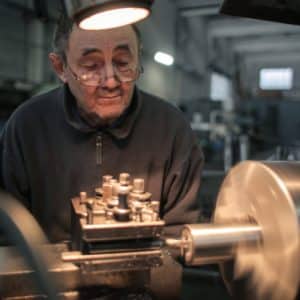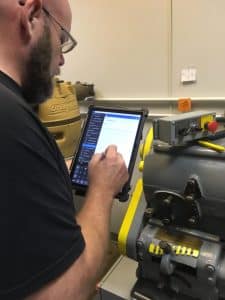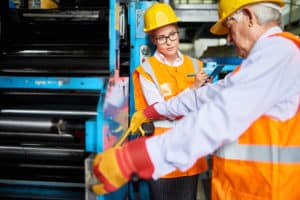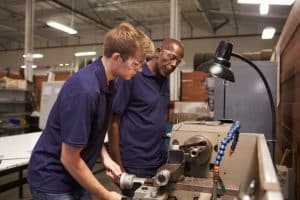
Bye-Bye Boomers: What Retiring Machinists Mean to Plant Safety
 Within the next decade approximately 2.7 million Baby Boomers (1946-1964) will retire, thereby ensuring that tens of thousands of positions will become available without a ready supply of American workers to fill them. Statistics paint an especially gloomy picture for the manufacturing sector, and the resulting widening of the skills gap as young replaces old.
Within the next decade approximately 2.7 million Baby Boomers (1946-1964) will retire, thereby ensuring that tens of thousands of positions will become available without a ready supply of American workers to fill them. Statistics paint an especially gloomy picture for the manufacturing sector, and the resulting widening of the skills gap as young replaces old.
Compared to the rest of the economy, the impact on manufacturing of this generational shift is over sized because of two reasons: One, despite increased efforts by colleges and vocational schools to train new manufacturing workers, available jobs still outpace qualified employees. And two, the existing manufacturing workforce is considerably older than the national employee average of 42 years. Currently, the average age of highly-skilled manufacturing employees is 56, and nearly a third of all manufacturing professionals are over 50. As they retire, knowledge goes out the door with them.
What are the implications of these trends for your plant’s productivity? How will it impact employee safety? What can you do to transfer knowledge from one generation to the next?
SAFETY KNOWLEDGE GAP
Besides having less experience operating machinery correctly, workers new to the job are often unsure about their safety rights and responsibilities, or might feel uncomfortable speaking out about a potential hazard. They may also not have the proper training, so they underestimate the risks involved with operating high-speed machinery. A recent survey of machinists in North America exposed that 70 percent could not recall receiving any formal training when they first hired on.
Equally troubling, the Millennials (1980-1996), who are replacing Baby Boomers, are more apt to job hop — 90 percent expect to stay in a job for less than three years, leaving manufacturers with heightened turnover and a badly depleted knowledge base, especially when it comes to safety.
 Given all this, it probably comes as little surprise that employees under the age of 25 are twice as likely to visit the emergency room for an occupational injury than those over 25. The dangers facing younger workers underscore the critical importance of machine safeguarding. The lathe, press or saw on the plant floor considered “safe” solely on the basis of being accident free for many years is no guarantee that modern safety standards are being met. Seasoned machinists may have developed workarounds that prevented accidents. Worse yet, the machinist may have covered up small accidents they’d suffered, considering an occasional nick or scratch simply part of the job. Your “safe” machine may be the most dangerous on the floor.
Given all this, it probably comes as little surprise that employees under the age of 25 are twice as likely to visit the emergency room for an occupational injury than those over 25. The dangers facing younger workers underscore the critical importance of machine safeguarding. The lathe, press or saw on the plant floor considered “safe” solely on the basis of being accident free for many years is no guarantee that modern safety standards are being met. Seasoned machinists may have developed workarounds that prevented accidents. Worse yet, the machinist may have covered up small accidents they’d suffered, considering an occasional nick or scratch simply part of the job. Your “safe” machine may be the most dangerous on the floor.
Step One: Safeguarding
Faced with the wave of Baby Boomer retirements, many manufacturers are trying to hold on to their older workers, persuade some to return after retirement or recruit those retired from other companies. Unfortunately, these steps only postpone the inevitable. A more successful, long-term answer is having your plant’s machinery subject to a thorough risk assessment process.
 A risk assessment draws on the expertise and experience of an outside company to identify machine hazards before they cause accidents. Over the course of the assessment, detailed information is collected concerning each machine, its operator and the process it is tied to. Hazardous areas are pinpointed on the machine with a risk level assigned to each potential danger. Evaluating this risk level helps determine if further safeguarding methods should be applied to the machine to make it safe. If a risk is not tolerable, safeguarding measures need to be applied that will reduce the risk to an acceptable level that is in accordance with national, regional and local regulations. The risk assessor should also accurately identify all costs associated with the final project. After installing safeguards, a follow-up assessment will be conducted to verify that risk levels have been reduced to a code-compliant, tolerable level that will not threaten the safety of less experienced employees.
A risk assessment draws on the expertise and experience of an outside company to identify machine hazards before they cause accidents. Over the course of the assessment, detailed information is collected concerning each machine, its operator and the process it is tied to. Hazardous areas are pinpointed on the machine with a risk level assigned to each potential danger. Evaluating this risk level helps determine if further safeguarding methods should be applied to the machine to make it safe. If a risk is not tolerable, safeguarding measures need to be applied that will reduce the risk to an acceptable level that is in accordance with national, regional and local regulations. The risk assessor should also accurately identify all costs associated with the final project. After installing safeguards, a follow-up assessment will be conducted to verify that risk levels have been reduced to a code-compliant, tolerable level that will not threaten the safety of less experienced employees.
Step Two: Transferring Tribal Knowledge


Retirees won’t leave behind every bit of knowledge they’ve gained over the years, but capturing a majority of the important nuggets will be beneficial down the road. Your organization needs to find ways of capturing this “tribal” knowledge before the machinist hangs up their hat and heads for the white sandy beaches of retirement. One common way of doing so is implementing a structured mentoring program pairing young workers with senior people who are technically expert in complex machinery. Along with face-to-face training on the machinery, the experienced worker is there to answer questions about operating procedures that are unclear or not understood, and to help the young worker learn the ropes of a new job.
Recognizing hazards and learning safe work practices must be central part of mentoring programs so make sure they are given equal billing with productivity during conversations. Mentors can also play an important role in informing young workers of their OSHA rights to a safe workplace, as well as the right to refuse unsafe work. Once retired, the mentor can return on a part-time or as needed basis to continue training new hires.
TRAINING
While older machinists certainly have the experience and technical knowledge, they may not know how to teach because they aren’t professional trainers or they can’t communicate effectively with a younger generation. Others may feel that training is an additional obligation that has been hoisted upon them when they are already crunched for time.
Hiring an outside firm to teach young employees about machine safety overcomes those problems. Rockford Systems offers Machine Safeguarding Seminars at its Rockford Systems Training Center in Rockford, Illinois. The popular 2.5-day seminars combine classroom discussion with live demonstrations on fifteen machines set up to give the hands-on experience that new employees need. Once the seminar is complete, the employee will be enable to interpret the OSHA 29 CFR 1910 and ANSI B11 Series Standards as they relate to their specific machine applications and production requirements, perhaps better than the retired operator they are replacing.
AGAIN, IMPORTANCE OF RISK ASSESSMENTS & SAFEGUARDING
A perfect storm has formed, making it increasingly difficult for manufacturers to find and train labor. The retirement of the Baby Boom generation only makes matters more challenging. To ensure plant productivity and safety needs are continuously met despite retirements, take proactive steps by conducting a risk assessment of machines, work to promote the transfer of knowledge, and install code-compliant safeguarding equipment.
Share this post
Media Contacts
Kari Larson
Rockford Systems, LLC
800-922-7533
[email protected]
Dan O’Connell
O’Connell Communications
708-363-6118
[email protected]
Subscribe to our newsletter
Logo Guidelines
Related Articles
-
An Overview of Perimeter Safeguarding
-
An Overview of Perimeter Safeguarding (Press Release)
-
Rockford Systems Announces Summer Schedule for Online Machine Safeguarding Seminars
-
Rockford Systems Gauge Ensures Machine Safeguarding Meets OSHA, ANSI, and CSA Point-of-Operation Requirements
-
Rockford Systems Donates Safeguarding Machines, Classroom Curriculum Development, and On-site Safety Training to Slippery Rock University
-
Rockford Systems Offers Assistance in Interpreting Recent Changes to OSHA Enforcement Guidance
-
“Zero Force” Optical Touch Button Control System Prevents Repetitive Motion Injuries
-
Rockford Systems Announces New Website Launch
-
What to Do if You are Issued an OSHA Citation
-
Do Your Machines Have Anti-Restart Protection? Here's How to Find Out
-
Rockford Systems Sensing-Saf-Start Protects Machine Operators from Accidental Re-starts following Power Interruptions
-
What The Wave of Retiring Machinists Means to Plant Safety
-
Machine Safeguarding Technology Keep Operators Out of a Pinch
-
Do's and Dont's of Safely Using Bench Grinders
-
Do’s and Don’ts of Safely Using Bench Grinders
-
How Rockford Systems Light Curtains Can Brighten Employee Safety in Your Plant
-
Rockford Systems Introduces Protector Series Light Curtains with Expanded Features
-
Protector™ Series Light Curtains with Expanded Features
-
Surge in Omicron Variant Cases Underscores Continued Need for COVID-19 Shielding
-
Annual Machine Safeguarding Audit Service
-
A Guide to Innovations in Safety Shields: LED lighting, Design Modularity Heighten Operator Protection
-
Machine Guarding Named to OSHA's Top Ten Violations in 2021
-
Training Workshop Addresses Combustion System Safety
-
Pressure-Sensitive Safety Mats Prevent Employee Injuries: Detects presence of workers around hazardous machines
Our Mission
To reduce risk and prevent workplace
injuries by becoming our customer’s trusted
advisor and source for machine safeguarding
training, assessment services, and provider
of turnkey engineered safeguarding solutions.
Location
5795 Logistics Parkway
Rockford Illinois 61109
Phone
1-800-922-7533
Useful Links
Hours of Operation
Copyright 2024. All Rights Reserved By Rockford Systems LLC



